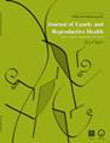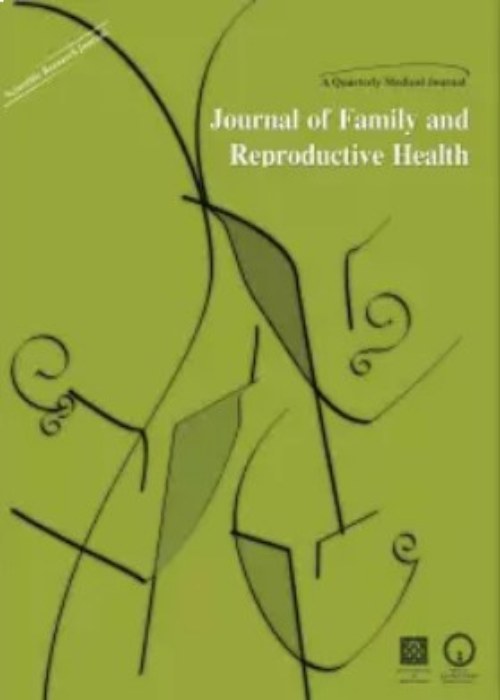فهرست مطالب

Journal of Family and Reproductive Health
Volume:10 Issue: 1, Mar 2016
- تاریخ انتشار: 1395/02/25
- تعداد عناوین: 8
-
-
Pages 1-8ObjectiveVitamin D appears to be involved in regulation of glycemic and inflammatory responses in gestational diabetes. The purpose of this study was to compare the serum levels of 25-hydroxyvitamin D (25(OH)D), inflammatory biomarkers and glycemic profile between gestational diabetes mellitus (GDM) and normal glucose tolerance (NGT) pregnant women.Materials And MethodsIn this cross-sectional study, fasting serum levels of 25(OH)D, insulin, glucose, HOMA-IR, hs-CRP and TNF-α were measured in 45 GDM and 45 NGT women at week 20-30 gestation whom referred to Reference Medical Laboratory of Ahvaz, Iran in 1394.ResultsSerum 25(OH)D levels were significantly lower (p = 0.003 ) in the GDM group compared to the NGT group which remained even after controlling for confounders. Insulin and TNF-α levels were not statistically different between groups (p > 0.05). However, in unadjusted model, HOMA-IR and hs-CRP were significantly different between groups that disappeared in adjusted model. In the GDM group, there was a negative significant correlation between 25 (OH) D and fasting blood sugar (p = 0.009) and pre pregnancy BMI (pConclusionThe lower level of vitamin D may be responsible for impairments of some glycemic and inflammatory markers in pregnant women. This is more important in overweight pregnant women. However, further studies with larger sample size are recommended in this regards.Keywords: Gestational Diabetes, TNF, α HS, CRP, HOMA, IR, Vitamin D
-
Pages 9-14ObjectiveThe study aimed to design and evaluate the content and face validity, and reliability of knowledge, attitude, and behavior questionnaire on preventive behaviors among vulnerable women concerning sexually transmitted diseases (STDs).Materials And MethodsThis cross-sectional study was carried out in two phases of an action research. In the first phase, to explain STDs preventive domains, 20 semi- structured interviews were conducted with the vulnerable women, residing at women prison and women referred to counseling centers. After analyzing content of interviews, three domains were identified: improve their knowledge, modify their attitude and change their behaviors. In the second phase, the questionnaire was designed and tested in a pilot study. Then, its content validity was evaluated. Face validity and reliability of the questionnaire were assessed by test re- test method and Cronbach alpha respectively.ResultsIndex of content validity in each three domain of the questionnaire (knowledge, attitude and behavior concerning STDs) was obtained over 0.6. Overall content validity index was 0.86 in all three domains of the questionnaire. The Cronbachs alpha as reliability of questionnaire was 0.80 for knowledge, 0.79 for attitude and 0.85 for behavior.ConclusionThe results showed that the designed questionnaire was a valid and reliable tool to measure knowledge, attitude and behavior of vulnerable women, predisposed to risk of STDs.Keywords: Sexually Transmitted Diseases, Knowledge, Attitude, Content Validity, Reliability
-
Pages 15-20ObjectiveCalpains are a family of Ca2 dependent proteases. There is some evidence that calpains involved in fusion process that occurs between spermatozoa and the oocyte. The current study aimed to investigate the association of smoking with semen quality and µ-calpain level.Materials And MethodsThis case-control study was conducted on 117 normospermia males between June 2013 and march 2014 in Jahad Laboratory in ahvaz, Iran. The semen samples were collected from male smokers (n = 50) and non-smokers (n = 67). We divided these participants as light, moderate, or heavy smokers based on their cigarettes per day (CPD). ELISA assays were used to measure µ-calpain concentration. All semen samples were analyzed according to World Health Organization guidelines.ResultsThe analysis of semen showed the volume, concentration, motility and morphology of semen were significantly lower among the smoker men than the non-smoker men. Also this significant difference was observed based on the number (light, moderate and heavy smokers) and duration (short term and long term smoker) of smoking. Although, showed no significant difference between µ-calpain of smoker men and non-smoker men. CPD showed negatively correlation with semen volume, concentration, motility and morphology of sperm.ConclusionSperm quality was negatively correlated with CPD and duration of smoking. However, there is no significant correlation between smoking and µ-calpain concentration.Keywords: Case, Control Study, Smoking, Semen, Calpain
-
Pages 21-26ObjectiveTo compare the efficacy of EMLA cream and lidocaine injection to reduce pain during episiotomy repair.Materials And MethodsA total of 46 primiparous women with normal pregnancy who referred for normal vaginal delivery and needed episiotomy repair were selected and randomly divided into two groups. For EMLA group, one hour before the estimated time of delivery, 5g of EMLA cream was applied to perinealmediolateral incision, and after the delivery of the fetus and placenta, again 5g of EMLA cream was applied to healthy skin around the episiotomy for repair. In the other group, lidocaine 2% was used before episiotomy and for its repair, too.ResultsOnly 8 people (19%) were in need of further analgesia. The mean ± SD of pain during repair of episiotomy on the VAS scale in all cases was 4.2 ± 2.3 cm. Most people (97%) were satisfied with their episiotomy repair. Comparing the two groups of EMLA and lidocaine, there was no difference between the two groups in terms of the duration of episiotomy repair, need for further analgesia, pain on the VAS scale, and satisfaction with the repair method.ConclusionThe findings of this study showed that the use of EMLA cream in the site of episiotomy incision in primiparous women can induce a level of analgesia equal to that of lidocaine, and cause a similar level of satisfaction.Keywords: Episiotomy, Pain, Lidocaine, Lidocaine Prilocaine Cream (EMLA)
-
Pages 27-34ObjectiveTo compare the effects of two auditory methods by mother and fetus on the results of NST in 2011-2012.Materials And MethodsIn this single-blind clinical trial, 213 pregnant women with gestational age of 37-41 weeks who had no pregnancy complications were randomly divided into 3 groups (auditory intervention for mother, auditory intervention for fetus, and control) each containing 71 subjects. In the intervention groups, music was played through the second 10 minutes of NST. The three groups were compared regarding baseline fetal heart rate and number of accelerations in the first and second 10 minutes of NST. The data were analyzed using one-way ANOVA, Kruskal-Wallis, and paired T-test.ResultsThe results showed no significant difference among the three groups regarding baseline fetal heart rate in the first (p = 0.945) and second (p = 0.763) 10 minutes. However, a significant difference was found among the three groups concerning the number of accelerations in the second 10 minutes. Also, a significant difference was observed in the number of accelerations in the auditory intervention for mother (p = 0.013) and auditory intervention for fetus groups (pConclusionMusic intervention was effective in the number of accelerations which is the indicator of fetal health. Yet, further studies are required to be conducted on the issue.Keywords: Auditory, Fetus, Non Stress Test, Mother
-
Pages 35-41ObjectiveTo compare the pregnancy outcomes achieved by in vitro fertilization (IVF) between minimal stimulation and conventional antagonist protocols in poor ovarian responders (PORs).Materials And MethodsIn this randomized controlled trial, 77 PORs undergoing IVF were selected and divided into two groups. First group was the minimal stimulation group (n = 42) receiving 100 mg/day clomiphene citrate on day 2of the cycle for 5 day that was followed by150IU/day human menopausal gonadotropin (hMG) on day 5 of the cycle. Second group was the conventional group (n = 35) receiving at least 300IU/daygonadotropin on day 2 of the cycle. Gonadotropin-releasing hormone (GnRH) antagonist protocol was applied for both groups according to flexible protocol. Number of retrieved oocytes and chemical pregnancy rate were the main outcomes.ResultsThere was no difference in number ofretrieved oocyte and pregnancy rate (2.79 ± 1.96 vs. 2.20 ± 1.71 and 5.6% vs. 4.1%; p > 0.05) between both groups. The gonadotropin dose used in the minimal stimulation group was lower than conventional group (1046 ± 596 vs. 2806 ± 583).ConclusionMinimal stimulation protocol with lower gonadotropin used is likely to be considered as a patient- friendly and cost-effective substitute for PORs.Keywords: In Vitro Fertilization, Conventional Antagonist Protocol, Minimal Stimulation Protocol, Poor Ovarian Responders
-
Pages 42-48ObjectiveSince there is still controversy regarding the best first-line choice for ovulation induction (OI) other than clomiphene citrate (CC) in infertile women diagnosed with polycystic ovary syndrome (PCOS), the aim of the present study was to compare recombinant human FSH with CC as the first course of OI in these women.Materials And MethodsIn this pilot randomized controlled trial, 104 infertile women diagnosed with PCOS were randomized in two groups to receive either CC with the dose of 100mg per day from day 3 of a spontaneous or progestin-induced menstruation for 5 days or rFSH with the starting dose of 50 IU daily {and weekly dose increment of as low as 12.5 IU}, on the day4 of the cycle. They were assessed during a single OI course. The pregnancy rate (PR) and live birth rate (LBR) were the primary outcomes. The follicular response, endometrial thickness, cancellation of the cycles and ovarian hyper stimulation (OHSS) rate were the secondary outcomes.ResultsAnalyzing data of 96 patients using Chi2 and Fischers Exact test (44 in rFSH group and 52 in CC group), both PR and LBR were comparable in the two groups {13.6% vs. 9.6% and 11.4% vs. 9.6% respectively}, with the difference not to be significant (p > 0.05). No cases of OHSS or multiple gestations happened during the treatment course.ConclusionIt seems that rFSH is as efficacious as CC while not with more complications for the first-line OI in infertile women with PCOS. However, due to the limitations of the present study including the small population and the single cycle of treatment, our results did not come out to prove this and more studies with larger study population are needed to compare the cumulative PR and LBR.Keywords: Polycystic Ovary Syndrome, Clomiphene Citrate, Recombinant FSH, Ovulation Induction
-
Pages 49-51Neurofibromas commonly involve peripheral nervous system. Isolated neurofibroma of vagina is very rare tumor and usually associated with Von Recklinghausens disease. Vulva is the most frequent location of neurofibroma of genital tract followed by clitoris and labia. We present a rare case of neurofibroma of vaginal wall presented as vaginal cyst in a 52 year old female with no history of any other symptoms related to Recklinghausens disease. Excision biopsy was done and on the histopathological examination non-encapsulated, well circumscribed mass composed of spindle shaped cells with wavy nuclei and bland nuclear chromatin was noted. Immunohistochemistry revealed strong positivity with S-100.Keywords: Vaginal Cyst, Neurofibroma, Histopathology


